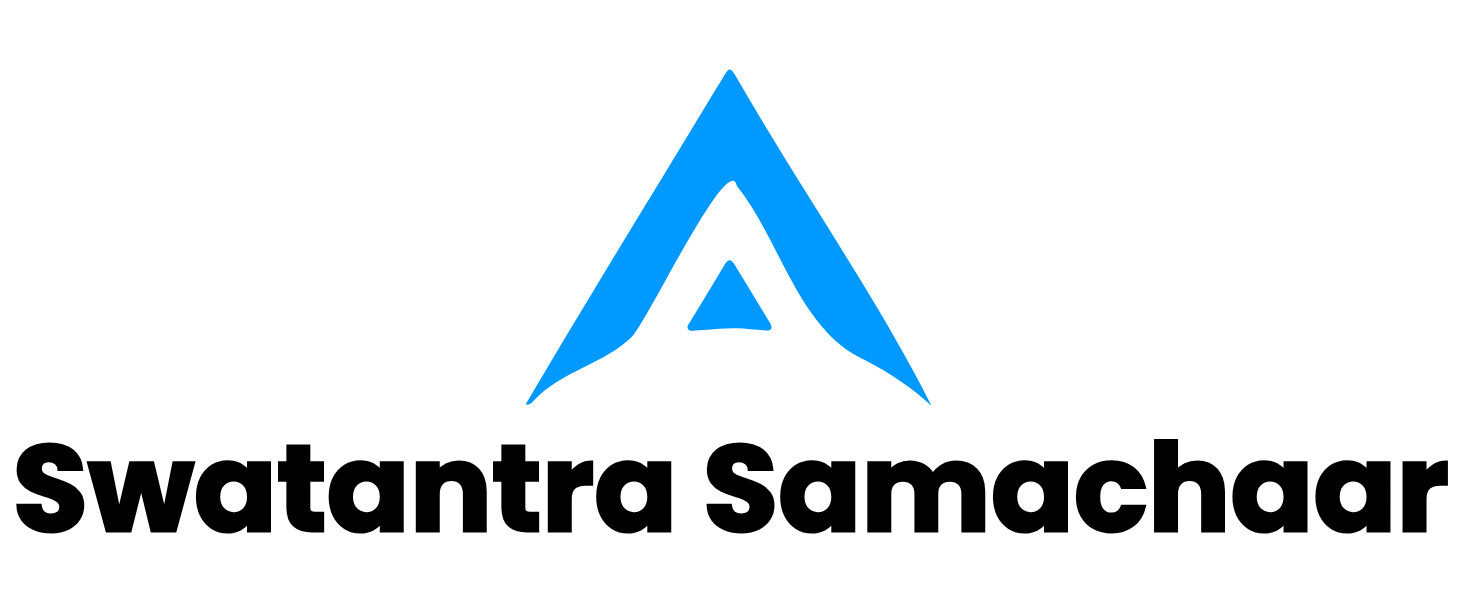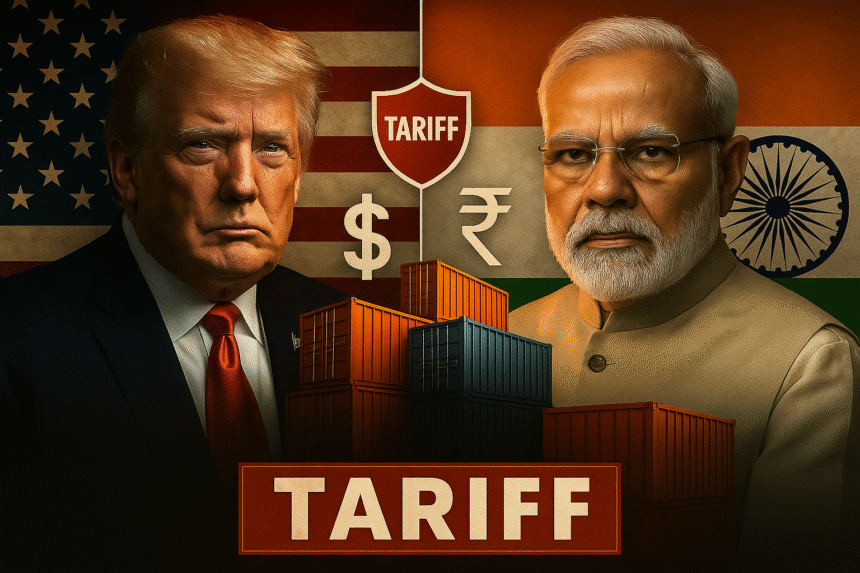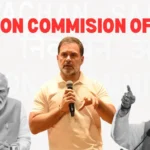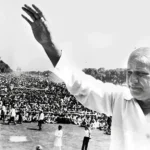The economic relationship between the United States and India has reached a critical juncture as President Donald Trump escalated his trade war to unprecedented levels, imposing a crushing 50% tariff on Indian goods that places India among the most heavily penalized trading partners in U.S. history. This comprehensive analysis examines the multifaceted implications of Trump’s tariff policy on India, exploring the underlying causes, economic consequences, and strategic ramifications that are reshaping bilateral relations between the world’s oldest and largest democracies.
- Trump Tariffs India: The Dramatic Escalation of Trump’s India Tariff Policy
- Comparative Analysis of Global Tariff Structure
- The Russian Oil Connection: Energy Security Versus Geopolitical Pressure
- Comprehensive Economic Impact Assessment
- Sector-Specific Analysis and Competitive Implications
- Textiles and Apparel Industry Under Siege
- Pharmaceutical Sector: Strategic Exemption and Future Uncertainty
- Gems, Jewelry, and Diamond Processing
- Trade Statistics and Export Vulnerability Analysis
- The Collapse of Trade Negotiations: Diplomatic Miscalculations
- Geopolitical Ramifications and Strategic Consequences
- BRICS Membership and Anti-American Policies
- Quad Alliance and Indo-Pacific Strategy
- India’s Strategic Response Framework
- Immediate Relief Measures for Exporters
- Market Diversification and Alternative Partnerships
- Future Scenarios and Strategic Outlook
- Negotiated Resolution Through Diplomatic Engagement
- Prolonged Standoff and Gradual Adaptation
- Escalating Trade War and Strategic Decoupling
- Strategic Recommendations for Stakeholders
- Government Policy Initiatives
- Business Strategy Adaptations
- Conclusion: Navigating the New Reality of Economic Nationalism
- FAQ
Trump Tariffs India: The Dramatic Escalation of Trump’s India Tariff Policy
The transformation of U.S.-India trade relations from partnership to confrontation represents one of the most significant policy reversals in recent diplomatic history. Trump’s tariff assault on India occurred through a calculated two-phase approach that has fundamentally altered the competitive landscape for Indian exporters in the American market.
The initial phase began on August 1, 2025, when the Trump administration imposed a 25% “reciprocal tariff” on Indian goods as part of a broader policy targeting 69 countries worldwide. This was justified under the administration’s argument that India maintained unfairly high barriers against American exports, creating an unbalanced trading relationship that disadvantaged U.S. businesses and workers.
The second and more devastating phase came just six days later on August 6, 2025, when Trump announced an additional 25% penalty tariff specifically targeting India’s continued imports of Russian crude oil. This brought India’s total tariff burden to a staggering 50%, effectively doubling the cost of Indian goods for American consumers and businesses overnight.
The combined tariff structure now places India at the apex of Trump’s trade penalty hierarchy, sharing the dubious distinction with Brazil as the most heavily taxed trading partner. This punitive rate significantly exceeds the tariffs imposed on other major economies and regional competitors, creating substantial competitive disadvantages for Indian exporters.
Comparative Analysis of Global Tariff Structure
Trump’s tariff framework reveals a complex hierarchy of trade relationships and geopolitical considerations. The comprehensive tariff comparison demonstrates how India’s position has deteriorated relative to other nations, including traditional rivals and strategic competitors.
| Country | Current Tariff Rate (%) | Previous Rate (%) | Primary Reason |
|---|---|---|---|
| India | 50 | 25 | Russian oil imports |
| Brazil | 50 | 10 | Bolsonaro prosecution |
| Syria | 41 | 35 | Sanctions violations |
| China | 30 | 10 | Strategic competition |
| Canada | 35 | 10 | Trade negotiations |
| Pakistan | 19 | 25 | Cooperation deal |
| Vietnam | 20 | 15 | Trade cooperation |
| Japan | 15 | 10 | Alliance partner |
The stark contrast in treatment becomes particularly evident when comparing India’s 50% rate with Pakistan’s significantly reduced 19% tariff, which was lowered as part of a broader cooperation agreement that included energy exploration partnerships. This differential treatment has created additional diplomatic tensions and highlighted the transactional nature of Trump’s trade policy approach.
The Russian Oil Connection: Energy Security Versus Geopolitical Pressure
The primary catalyst for Trump’s tariff escalation centers on India’s strategic decision to dramatically increase imports of Russian crude oil following the Ukraine invasion in February 2022. This energy relationship has evolved from a negligible factor to the cornerstone of India’s crude oil supply strategy, fundamentally altering global energy trade patterns.
Before the Russia-Ukraine conflict, Russian oil represented a mere 0.2% of India’s total crude imports, with traditional Middle Eastern suppliers like Iraq and Saudi Arabia dominating the market. However, as Western sanctions created discounted Russian oil opportunities, India’s import strategy underwent a dramatic transformation that prioritized economic pragmatism over geopolitical alignment.
| Time Period | Russian Oil Imports (Million bpd) | Market Share (%) | Iraq Imports (Million bpd) | Saudi Imports (Million bpd) |
|---|---|---|---|---|
| January 2022 | 0.068 | 0.2 | 1.230 | 0.883 |
| June 2022 | 1.120 | 40.0 | 0.993 | 0.695 |
| May 2023 | 2.150 | 42.0 | 1.100 | 0.800 |
| July 2024 | 2.000 | 41.0 | 1.000 | 0.600 |
| August 2025 | 1.780 | 36.0 | 0.900 | 0.702 |
The statistical progression demonstrates India’s rapid pivot toward Russian energy supplies, with imports peaking at 2.15 million barrels per day in May 2023. This strategic shift has generated substantial economic benefits for India, with ICRA estimates indicating savings of approximately $13 billion over two financial years due to discounted pricing structures.
Trump has characterized India’s Russian oil purchases as directly “fueling the war machine” and providing financial resources that enable Russia’s continued military operations in Ukraine. His administration’s executive order explicitly states that India’s imports constitute a “national emergency” that justifies the imposition of punitive tariffs as a means of economic coercion.
Comprehensive Economic Impact Assessment
The imposition of 50% tariffs on Indian goods has triggered widespread revisions to economic growth projections across major financial institutions and research organizations. The consensus among economists indicates that while the immediate impact may be manageable given India’s domestic demand-driven economy, the medium-term implications could significantly affect export-dependent sectors and overall growth momentum.
| Institution | GDP Growth Forecast 2025 (%) | Previous Forecast (%) | Revision (basis points) | Inflation Forecast 2025 (%) |
|---|---|---|---|---|
| Goldman Sachs | 6.5 | 6.6 | -10 | 3.0 |
| ICRA | 6.0 | 6.2 | -20 | 3.2 |
| SBI Research | 6.2 | 6.5 | -30 | 3.5 |
| Bank of Baroda | 6.4 | 6.6 | -20 | 3.1 |
| RBI | 6.5 | 6.5 | 0 | 3.1 |
Goldman Sachs has been among the most measured in its response, trimming its forecast for India’s real GDP growth by 0.1 percentage points for 2025 and 0.2 percentage points for 2026, now expecting the economy to expand by 6.5% and 6.4% respectively. The investment bank maintains that some tariffs are likely to be negotiated lower over time, with the primary downside risk emanating from uncertainty rather than direct trade impact.
More conservative estimates from ICRA suggest a 20 basis points reduction in growth forecast to 6.0% for FY26, while SBI Research projects a more substantial impact of 25-30 basis points on GDP growth. These projections reflect the interconnected nature of global trade relationships and the multiplier effects that tariff policies can generate throughout the economic system.
Sector-Specific Analysis and Competitive Implications
The 50% tariff structure creates differential impacts across various sectors of the Indian economy, with export-oriented industries bearing the brunt of competitive disadvantages. The analysis reveals that while some sectors may weather the storm through diversification strategies, others face existential challenges that could fundamentally reshape their market orientation.
| Sector | US Market Share (%) | Earnings Impact (%) | Competitive Disadvantage | Alternative Markets |
|---|---|---|---|---|
| Textiles & Apparel | 33 | 15-20 | High | Europe, Canada |
| Gems & Jewelry | 36 | 20-25 | High | Dubai, Belgium |
| Auto Components | 27 | 12-15 | Medium | Asia, Europe |
| Chemicals | 18 | 8-12 | Medium | Europe, Asia |
| Electronics | 12 | 10-15 | Medium | Asia, Europe |
| Pharmaceuticals | 15 | 2-8 | Low | Europe, Asia |
| Petroleum Products | 8 | 5-8 | Low | Asia, Middle East |
Textiles and Apparel Industry Under Siege
The textiles and apparel sector faces perhaps the most severe competitive challenge under the new tariff regime. With the United States representing 33% of India’s garment exports and 59% of home textile exports, the 50% tariff creates an insurmountable pricing disadvantage compared to regional competitors. Countries like Bangladesh, Vietnam, and Pakistan now enjoy tariff advantages of 5-6 percentage points, potentially triggering significant market share losses for Indian manufacturers.
The competitive landscape has shifted dramatically, with Asian nations collectively representing 70% of U.S. apparel imports now operating under vastly different cost structures. Vietnamese exporters face only 20% tariffs, while Bangladesh and Indonesian goods are subject to similar rates, creating compelling alternatives for American buyers seeking to minimize import costs.
Pharmaceutical Sector: Strategic Exemption and Future Uncertainty
The pharmaceutical industry has received relatively favorable treatment, with strategic exemptions maintained due to U.S. dependence on Indian generic medications. However, industry analysts warn that policy reversals or additional penalties could significantly impact earnings by 2-8% in FY26. The sector’s resilience stems from its critical role in American healthcare infrastructure, where Indian generics provide cost-effective alternatives to branded medications.
Despite current exemptions, the industry faces margin pressure due to the inability to pass through potential future tariff costs while maintaining competitiveness in the world’s largest pharmaceutical market. Companies are actively developing contingency plans that include supply chain diversification and enhanced focus on European and Asian markets.
Gems, Jewelry, and Diamond Processing
India’s dominance in diamond cutting and polishing faces direct threat from the tariff structure, with 36% of cut and polished diamond exports destined for the U.S. market. The 25% tariff may force Indian diamantaires to redirect exports through established trading hubs like Dubai, Belgium, and Israel to reach American consumers, adding logistical complexity and costs to supply chains.
This sector’s response demonstrates the adaptive capacity of Indian businesses, with companies exploring re-routing strategies that could maintain market access while circumventing direct tariff impacts. However, such approaches increase operational complexity and may erode profit margins over time.
Trade Statistics and Export Vulnerability Analysis
The comprehensive assessment of India’s export vulnerability reveals the scale of economic exposure created by Trump’s tariff policies. The analysis encompasses both direct impacts on current trade flows and potential scenarios that could unfold depending on the duration and scope of tariff implementation.
| Metric | Current Value | Best Case Scenario | Worst Case Scenario |
|---|---|---|---|
| Total Exports to US ($B) | 91.00 | 91.0 | 91.00 |
| Exports at Risk ($B) | 50.00 | 25.0 | 75.00 |
| Percentage at Risk (%) | 54.00 | 27.0 | 82.00 |
| Direct GDP Impact (%) | 0.19 | 0.1 | 0.35 |
| Jobs at Risk (Million) | 2.50 | 1.2 | 4.00 |
| Revenue Loss Estimate ($B) | 8.10 | 4.0 | 15.00 |
The current assessment indicates that approximately $50 billion worth of Indian exports to the United States face direct tariff impacts, representing 54% of the total $91 billion bilateral trade flow. This exposure creates immediate challenges for exporters while generating broader economic uncertainty that extends beyond directly affected sectors.
Industry associations estimate that 2.5 million jobs across export-oriented industries face potential impact, with revenue losses conservatively estimated at $8.1 billion under current tariff structures. These figures could escalate significantly if additional penalties are imposed or if retaliatory measures emerge from ongoing diplomatic tensions.
The Collapse of Trade Negotiations: Diplomatic Miscalculations
The current crisis represents the culmination of five rounds of failed trade negotiations that began with considerable optimism but devolved into mutual recriminations and policy deadlock. The breakdown reveals fundamental miscalculations on both sides regarding negotiating positions, political constraints, and strategic priorities.
Indian officials had initially expressed confidence that tariffs could be capped at 15%, based on positive signals from Trump administration representatives during early negotiation rounds. This optimism led to a firmer negotiating stance, particularly on politically sensitive sectors like agriculture and dairy, where nearly 44% of India’s workforce depends on agricultural activities.
The critical sticking points that derailed negotiations encompassed several key areas. Agricultural and dairy sector access remained non-negotiable for India due to domestic political sensitivities and farmer welfare considerations. India’s restrictions on genetically modified agricultural products created additional barriers that American negotiators found unacceptable.
Digital trade regulations and data localization requirements represented another significant obstacle, with American technology companies seeking greater market access and data flow freedoms. India’s price controls on medical devices and pharmaceutical products also generated friction, as U.S. manufacturers argued these policies created unfair competitive disadvantages.
The most fundamental disagreement centered on India’s energy and defense relationships with Russia, which American negotiators viewed as incompatible with strategic partnership expectations. This geopolitical dimension ultimately proved impossible to resolve within the confines of trade negotiations, leading to the current confrontational approach.
Geopolitical Ramifications and Strategic Consequences
The tariff war extends far beyond economic considerations, threatening to undermine decades of carefully constructed strategic partnerships and regional security arrangements. The implications reverberate through multiple dimensions of bilateral cooperation, from defense technology transfer to intelligence sharing arrangements.
BRICS Membership and Anti-American Policies
Trump has explicitly threatened an additional 10% tariff on countries aligning themselves with “Anti-American policies of BRICS,” placing India in a particularly vulnerable position as a founding member of the grouping that includes China, Russia, South Africa, and Brazil. This threat creates a direct challenge to India’s multi-alignment foreign policy approach, forcing choices between economic interests and strategic autonomy.
The BRICS dimension adds complexity to India’s response options, as complete accommodation to American demands could undermine relationships with other major powers while failing to guarantee long-term tariff relief. This dynamic illustrates the broader challenge of maintaining strategic autonomy in an increasingly polarized global environment.
Quad Alliance and Indo-Pacific Strategy
The deteriorating trade relationship threatens to undermine the Quadrilateral Security Dialogue (Quad), which has been a cornerstone of U.S. Indo-Pacific strategy designed to counter China’s growing regional influence. The alliance, comprising the United States, India, Japan, and Australia, was predicated on shared democratic values and common security interests.
Trade tensions could complicate military cooperation initiatives, including proposed acquisitions of advanced defense systems like Javelin anti-tank missiles, Stryker combat vehicles, and P-8I maritime patrol aircraft. Technology transfer agreements that form the foundation of deepening defense cooperation also face potential disruption if economic relationships continue to deteriorate.
India’s Strategic Response Framework
The Indian government has developed a multi-pronged response strategy that balances immediate economic relief measures with longer-term diversification initiatives designed to reduce dependence on the American market. This comprehensive approach encompasses both defensive measures to protect existing exporters and offensive strategies to develop alternative trading relationships.
Immediate Relief Measures for Exporters
The government has announced several targeted interventions to support affected exporters during the transition period. The extension of the RoDTEP (Remission of Duties and Taxes on Exported Products) scheme provides crucial support for maintaining competitiveness despite tariff burdens. Similarly, the continuation of the RoSCTL (Rebate of State and Central Taxes and Levies) scheme offers additional relief for specific sectors.
Interest rate subsidies for exporters help offset increased working capital costs associated with longer payment cycles and reduced margins. The government has also committed to faster reimbursement of pending dues, improving cash flow for companies facing immediate financial pressures from tariff-related disruptions.
Direct shipping line establishment initiatives aim to reduce logistics costs and improve supply chain efficiency, partially offsetting tariff-related cost increases through operational improvements. These measures demonstrate the government’s recognition that tariff challenges require comprehensive support rather than isolated interventions.
Market Diversification and Alternative Partnerships
The strategic response emphasizes accelerated diversification toward alternative markets that offer growth potential and reduced geopolitical risk. European Union expansion represents a primary focus, with recent free trade agreement negotiations potentially opening new opportunities for displaced American exports.
Enhanced partnerships with Canada and Latin American countries provide additional outlets for traditional export sectors, while leveraging existing trade agreements with ASEAN nations offers immediate alternative market access. Middle East partnerships, particularly in energy and infrastructure sectors, present opportunities for expanded economic cooperation.
The approach recognizes that successful diversification requires sustained effort and relationship building rather than reactive reallocation of existing trade flows. This long-term perspective underpins the government’s confidence in weathering current challenges while building more resilient trading relationships.
Future Scenarios and Strategic Outlook
The resolution of the current crisis depends on multiple variables, including domestic political considerations in both countries, global economic conditions, and broader geopolitical developments. Three primary scenarios emerge from current trends and policy trajectories, each with distinct implications for bilateral relations and regional stability.
Negotiated Resolution Through Diplomatic Engagement
The most optimistic scenario envisions successful resolution through the upcoming sixth round of trade talks scheduled for August 25-29, 2025. This outcome would require significant concessions from both sides, including Indian flexibility on agricultural market access and American recognition of India’s energy security imperatives.
Success factors include direct communication between Prime Minister Modi and President Trump, potentially bypassing technical negotiating teams that have struggled to find common ground. Limited agricultural sector concessions, particularly in processed foods rather than primary commodities, could provide face-saving compromises for both sides.
Gradual reductions in Russian oil imports, coupled with increased purchases of American LNG and crude oil, could address energy-related concerns while maintaining India’s energy security. Enhanced defense and technology cooperation, including expedited approval of pending defense contracts, could demonstrate commitment to strategic partnership while creating constituencies supporting improved relations.
Prolonged Standoff and Gradual Adaptation
The most probable scenario involves an extended period of high tariffs accompanied by gradual adaptation on both sides. This outcome reflects the complex political dynamics underlying current tensions, where domestic considerations in both countries limit flexibility for dramatic policy reversals.
Under this scenario, Indian exporters would accelerate market diversification initiatives while developing strategies to maintain minimal American market presence in critical sectors. Selective concessions in less sensitive areas, such as intellectual property protection or digital trade facilitation, could provide incremental improvements without addressing core disagreements.
Continued tensions over Russian energy imports would persist, with periodic diplomatic overtures failing to achieve breakthrough results. This dynamic would reflect the fundamental challenge of reconciling India’s multi-alignment foreign policy with America’s expectation of strategic alignment on major geopolitical issues.
Escalating Trade War and Strategic Decoupling
The most concerning scenario involves further escalation that could fundamentally damage bilateral relationships across multiple dimensions. Additional penalties beyond the current 50% rate could target previously exempted sectors like pharmaceuticals, creating broader economic disruption.
Complete breakdown in strategic cooperation would extend beyond trade to encompass defense technology transfer, intelligence sharing, and multilateral cooperation on regional security issues. India’s potential pivot toward alternative partnerships, particularly with European and Asian economies, could reshape regional power dynamics.
This scenario would likely prompt broader questions about the sustainability of American alliance relationships in an era of transactional foreign policy, potentially weakening U.S. influence across the Indo-Pacific region. The implications extend beyond bilateral relations to encompass broader questions of global trade governance and strategic stability.
Strategic Recommendations for Stakeholders
The current crisis requires coordinated responses from government policymakers, business leaders, and strategic planners across multiple sectors. The recommendations encompass immediate tactical adjustments and longer-term strategic reorientations designed to enhance resilience against future trade disruptions.
Government Policy Initiatives
Policymakers should prioritize accelerated negotiation of comprehensive trade agreements with alternative partners, particularly the European Union, Canada, and major Asian economies. These agreements should incorporate lessons learned from current U.S. negotiations, emphasizing flexibility and mutual benefit rather than zero-sum approaches.
Investment in domestic manufacturing capabilities, particularly in sectors currently dependent on American markets, could reduce export vulnerabilities while strengthening the domestic economy. Strategic support for technology development and innovation ecosystems would enhance long-term competitiveness across multiple markets.
Enhanced diplomatic engagement with regional partners, including strengthening of existing multilateral arrangements like ASEAN Plus mechanisms, could provide additional frameworks for economic cooperation that reduce dependence on bilateral relationships with individual major powers.
Business Strategy Adaptations
Companies should implement comprehensive supply chain diversification strategies that reduce concentration risk while maintaining operational efficiency. This includes establishing alternative manufacturing locations, developing multiple supplier relationships, and creating flexible logistics networks capable of rapid reconfiguration.
Investment in product differentiation and premium positioning could help offset tariff-related cost increases through enhanced value propositions. Companies should focus on developing unique capabilities that are difficult to replicate, creating sustainable competitive advantages independent of tariff structures.
Strategic partnerships with international firms, including joint ventures and licensing agreements, provide mechanisms for maintaining market access while sharing risks associated with trade policy volatility. These relationships should emphasize complementary capabilities and mutual benefit rather than defensive arrangements.
Conclusion: Navigating the New Reality of Economic Nationalism
The imposition of 50% tariffs on India represents more than a bilateral trade dispute; it signifies a fundamental shift toward economic nationalism that challenges established patterns of global integration and cooperation. The crisis demonstrates how quickly decades of relationship building can unravel when economic interests collide with geopolitical expectations.
India’s response must balance multiple competing imperatives: maintaining strategic autonomy while preserving beneficial economic relationships, protecting domestic interests while remaining open to international cooperation, and defending principled positions while remaining flexible enough to adapt to changing circumstances.
The ultimate resolution will likely require creative diplomatic solutions that acknowledge legitimate concerns on both sides while establishing frameworks for managing future disagreements. Success depends on recognizing that economic relationships cannot be separated from broader strategic considerations, while ensuring that short-term tactical advantages do not undermine long-term strategic interests.
The Trump tariffs on India serve as a case study in the challenges facing middle powers in an era of great power competition. The outcome will influence not only bilateral U.S.-India relations but also broader patterns of international economic cooperation and the sustainability of rules-based trading systems in an increasingly fragmented global economy.
As negotiations resume and diplomatic efforts continue, the world watches to see whether pragmatic solutions can emerge from ideological divisions, and whether the bonds forged through shared democratic values and common interests can withstand the pressures of economic nationalism and strategic competition.
FAQ
What is the current Trump tariff rate on Indian goods?
India currently faces a total of 50% tariffs – 25% reciprocal tariff plus an additional 25% penalty for Russian oil imports, making it one of the highest rates globally
When did Trump’s 50% tariffs on India take effect?
The initial 25% tariff began August 7, 2025, with the additional 25% penalty taking effect August 27, 2025, bringing the total to 50%
Why did Trump impose such high tariffs on India specifically?
The primary reasons include India’s massive Russian oil purchases (36% of total crude imports), failed trade negotiations, and what Trump calls unfair trade barriers against U.S. goods
Which Indian sectors are most severely impacted?
Textiles and apparel, gems and jewelry, auto components, chemicals, and electronics face the highest impact, with textiles seeing 15-20% earnings decline
How do India’s tariffs compare to other countries under Trump?
India’s 50% rate ties with Brazil as the highest, significantly exceeding China (30%), Pakistan (19%), and Vietnam (20%), creating major competitive disadvantages
What is the estimated impact on India’s GDP growth?
Leading economists project 20-30 basis points reduction in GDP growth, with forecasts ranging from 6.0% to 6.5% for 2025, down from earlier projections
How much Russian oil does India actually import?
India imports approximately 1.78 million barrels per day of Russian crude, representing 36% of total oil imports, up from just 0.2% before the Ukraine war
Can India successfully negotiate lower tariffs with Trump?
New trade talks are scheduled for August 25-29, 2025, but success requires major concessions on agriculture, Russian energy ties, and other sensitive

















